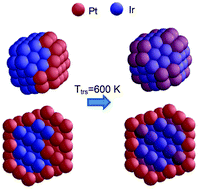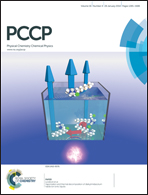Stabilization and transformation of asymmetric configurations in small-mismatch alloy nanoparticles: the role of coordination dependent energetics
Abstract
Chemical order in platinum–iridium truncated-octahedron nanoparticles as a model system was studied using coordination-dependent bond-energy variations (CBEV) and the statistical-mechanical free-energy concentration expansion method (FCEM) adapted for handling axially symmetric structures. Pt–Ir side-separated (“Quasi-Janus”, QJ) configurations are found to be stabilized at low temperatures mainly due to CBEV-related preferential strengthening of Pt-surface–Ir-subsurface bonds, and the greatly reduced number of hetero-atomic bonds. In comparison, the roles of local strain (by only ∼2% atomic mismatch), short-range-order and vibrational entropy are minor. At higher temperatures, the QJ configuration is transformed into a partially disordered central-symmetric onion-like structure, and the sharp transition is accompanied by extensive pre-transition atomic exchange processes, reflected in a lambda-type heat capacity curve. The nanoparticle composition and size dependent transition temperatures, which are well below the bulk miscibility gap, furnish the first Pt–Ir nanophase diagram, which is likely to represent a distinct class of asymmetrically phase-separated nanoalloys having negligible mismatch but large preferential bond strengthening at the near-surface region.


 Please wait while we load your content...
Please wait while we load your content...